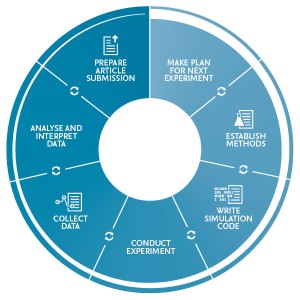What is Data Processing?
Data processing is simply the conversion of raw data to meaningful information through a process. Data is manipulated to produce results that lead to a resolution of a problem or improvement of an existing situation. Similar to a production process, it follows a cycle where inputs (raw data) are fed to a process (computer systems, software, etc.) to produce output (information and insights).
Generally, organizations employ computer systems to carry out a series of operations on the data in order to present, interpret, or obtain information. The process includes activities like data entry, summary, calculation, storage, etc. A useful and informative output is presented in various appropriate forms such as diagrams, reports, graphics, etc.
Stages of the Data Processing Cycle:

1) Collection is the first stage
of the cycle, and is very crucial, since the quality of data collected will impact heavily on the output. The collection process needs to ensure that the data gathered are both defined and accurate so that subsequent decisions based on the findings are valid. This stage provides both the baseline from which to measure and a target on what to improve.
Some types of data collection include census (data collection about everything in a group or statistical population), sample survey (collection method that includes only part of the total population), and administrative by-product (data collection is a byproduct of an organization’s day-to-day operations).
2) Preparation is the manipulation of data into a form suitable for further analysis and processing. Raw data cannot be processed and must be checked for accuracy. Preparation is about constructing a dataset from one or more data sources to be used for further exploration and processing. Analyzing data that has not been carefully screened for problems can produce highly misleading results that are heavily dependent on the quality of data prepared.
3) Input is the task where verified data is coded or converted into machine readable form so that it can be processed through a computer. Data entry is done through the use of a keyboard, digitizer, scanner, or data entry from an existing source. This time-consuming process requires speed and accuracy. Most data need to follow a formal and strict syntax since a great deal of processing power is required to break down the complex data at this stage. Due to the costs, many businesses are resorting to outsourcing this stage.
4) Processing is when the data is subjected to various means and methods of manipulation, the point where a computer program is being executed, and it contains the program code and its current activity. The process may be made up of multiple threads of execution that simultaneously execute instructions, depending on the operating system. While a computer program is a passive collection of instructions, a process is the actual execution of those instructions. Many software programs are available for processing large volumes of data within very short periods.
5) Output and interpretation are the stages where processed information is now transmitted to the user. An output is presented to users in various report formats like printed report, audio, video, or on a monitor. Output needs to be interpreted so that it can provide meaningful information that will guide future decisions of the company.
6) Storage is the last stage in the data processing cycle, where data, instruction, and information are held for future use. The importance of this cycle is that it allows quick access and retrieval of the processed information, allowing it to be passed on to the next stage directly when needed. Every computer uses storage to hold system and application software.
The Data Processing Cycle is a series of steps carried out to extract information from raw data. Although each step must be taken in order, the order is cyclic. The output and storage stage can lead to the repeat of the data collection stage, resulting in another cycle of data processing. The cycle provides a view on how the data travels and transforms from collection to interpretation, and ultimately, used in effective business decisions.















